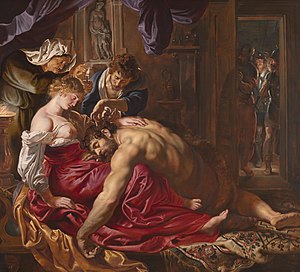Samson and Delilah (Rubens)
| Samson and Delilah | |
|---|---|
 |
|
| Artist | Peter Paul Rubens |
| Year | c. 1609–10 |
| Type | Oil on wood |
| Dimensions | 185 cm × 205 cm (73 in × 81 in) |
| Location | National Gallery (London) |
| Samson and Delilah (sketch) | |
|---|---|
 |
|
| Artist | Peter Paul Rubens |
| Year | c. 1609 |
| Medium | Oil on panel |
| Dimensions | 52.1 cm × 50.5 cm (20.5 in × 19.9 in) |
| Location | Cincinnati Art Museum |
Samson and Delilah is a painting by the Flemish Baroque painter Peter Paul Rubens (1577–1640) which is currently on display in the National Gallery. It dates from about 1609 to 1610. Two preliminary copies of the painting also exist today: an ink and wash drawing on paper, and an oil sketch on wood panel. The oil sketch is currently on display in the Cincinnati Art Museum, while the ink sketch is being held in a private collection in Amsterdam.
The painting depicts an episode from the Old Testament story of Samson and Delilah (Judges 16). Samson was a Hebrew hero known for fighting the Philistines. Having fallen in love with Delilah, who has been bribed by the Philistines, Samson tells her the secret of his great strength: his uncut hair. Without his strength, Samson is captured by the Philistines.
Rubens portrays the moment when, having fallen asleep on Delilah's lap, a young man cuts Samson's hair. Samson and Delilah are in a dark room, which is lit mostly by a candle held by an old woman to Delilah's left. Delilah is depicted with all of her clothes, but with her breasts exposed. Her left hand is on top of Samson's right shoulder, as his left arm is draped over her legs. The man snipping Samson's hair is crossing his hands, which is a sign of betrayal. Philistine soldiers can be seen in the right-hand background of the painting.
The niche behind Delilah contains a statue of the Venus, the Goddess of love, and her son, Cupid. Notably, Cupid's mouth is bound, rather than his eyes. This statue can be taken to represent the cause of Samson's fate and the tool of Delilah's actions.
The old woman standing behind Delilah, providing further light for the scene, does not appear in the biblical narrative of Samson and Delilah. She is believed to be a procuress, and the adjacent profiles of her and Delilah may symbolise the old woman's past, and Delilah's future.
The painting was originally commissioned by Nicolaas II Rockox, Lord mayor of Antwerp, Belgium, for his Rockox House. In addition to being a patron, Rockox was a close personal friend of Rubens. The painting was specifically intended to be placed above a 7-foot mantleshelf, where the painting would have been seen from below.
...
Wikipedia
